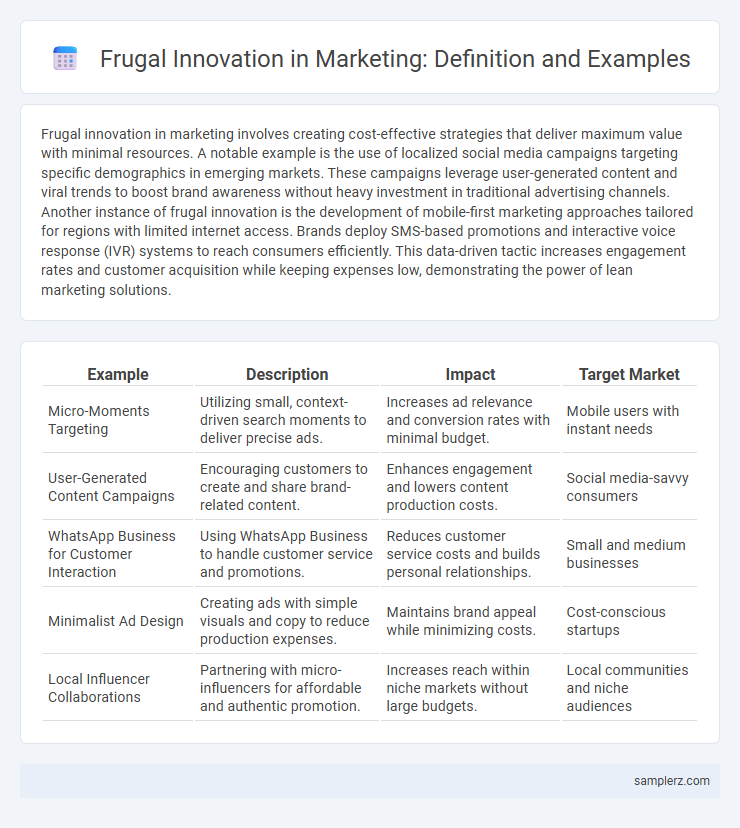Frugal innovation in marketing involves creating cost-effective strategies that deliver maximum value with minimal resources. A notable example is the use of localized social media campaigns targeting specific demographics in emerging markets. These campaigns leverage user-generated content and viral trends to boost brand awareness without heavy investment in traditional advertising channels. Another instance of frugal innovation is the development of mobile-first marketing approaches tailored for regions with limited internet access. Brands deploy SMS-based promotions and interactive voice response (IVR) systems to reach consumers efficiently. This data-driven tactic increases engagement rates and customer acquisition while keeping expenses low, demonstrating the power of lean marketing solutions.
Table of Comparison
| Example | Description | Impact | Target Market |
|---|---|---|---|
| Micro-Moments Targeting | Utilizing small, context-driven search moments to deliver precise ads. | Increases ad relevance and conversion rates with minimal budget. | Mobile users with instant needs |
| User-Generated Content Campaigns | Encouraging customers to create and share brand-related content. | Enhances engagement and lowers content production costs. | Social media-savvy consumers |
| WhatsApp Business for Customer Interaction | Using WhatsApp Business to handle customer service and promotions. | Reduces customer service costs and builds personal relationships. | Small and medium businesses |
| Minimalist Ad Design | Creating ads with simple visuals and copy to reduce production expenses. | Maintains brand appeal while minimizing costs. | Cost-conscious startups |
| Local Influencer Collaborations | Partnering with micro-influencers for affordable and authentic promotion. | Increases reach within niche markets without large budgets. | Local communities and niche audiences |
Introduction to Frugal Innovation in Marketing
Frugal innovation in marketing emphasizes cost-effective strategies that maximize impact with minimal resources, such as using social media platforms for targeted advertising in emerging markets. Leveraging user-generated content and micro-influencers enables brands to build trust and engagement without large budgets. This approach supports scalability and adaptability, making it ideal for startups and companies operating in resource-constrained environments.
Low-Budget Viral Campaigns: Case Studies
Low-budget viral campaigns demonstrate frugal innovation by leveraging social media platforms to maximize reach with minimal expenditure, such as the ALS Ice Bucket Challenge which generated over $115 million in donations through user participation and organic sharing. Another example is the Dollar Shave Club's launch video, producing over 26 million views and rapidly acquiring customers by combining humor and direct messaging on a shoestring budget. These campaigns exemplify efficient resource use and creative strategy, achieving significant impact without large advertising budgets.
Leveraging Social Media for Cost-Effective Outreach
Leveraging social media platforms like Instagram, Facebook, and TikTok enables brands to reach vast audiences with minimal budget through targeted ads and organic content. User-generated content and influencer partnerships amplify brand visibility while keeping marketing costs low. Analyzing engagement metrics allows marketers to optimize campaigns in real-time, maximizing ROI from limited resources.
Grassroots Marketing Strategies by Startups
Startups often leverage frugal innovation through grassroots marketing strategies by utilizing low-cost, community-driven approaches such as social media engagement, local events, and word-of-mouth referrals to maximize brand visibility. These tactics capitalize on authentic customer interactions and targeted outreach without extensive financial investment, driving organic growth in competitive markets. Employing guerrilla marketing techniques and influencer partnerships at a grassroots level enables startups to build strong customer loyalty while minimizing marketing expenses.
Creative Use of User-Generated Content
Brands leverage user-generated content (UGC) in marketing campaigns to drive engagement while minimizing production costs, exemplifying frugal innovation. By curating authentic customer photos, videos, and testimonials, companies build trust and foster community without expensive advertising budgets. This strategy enhances brand visibility and credibility efficiently, using customers as both creators and promoters.
Community Engagement with Minimal Resources
Community engagement through frugal innovation involves leveraging social media platforms and user-generated content to build brand loyalty without significant financial investment. Brands create interactive campaigns that encourage local communities to share their stories and experiences, effectively expanding reach at minimal costs. This approach fosters authentic connections while optimizing limited marketing budgets.
Partnerships and Collaborations for Mutual Growth
Frugal innovation in marketing leverages strategic partnerships and collaborations to maximize resources and reach underserved markets with minimal investment. Brands like Unilever partnered with local retailers and micro-entrepreneurs to distribute affordable products in rural areas, driving mutual growth and expanding market presence. These collaborative efforts enable cost-effective marketing campaigns and shared value creation, fostering sustainable business ecosystems.
DIY Marketing Tools and Techniques
Frugal innovation in marketing leverages DIY marketing tools like Canva for graphic design, Mailchimp for email campaigns, and Google Analytics for performance tracking, enabling businesses to maximize impact with minimal budget. Small enterprises utilize social media scheduling apps such as Buffer to streamline content delivery without hiring dedicated teams. These cost-effective techniques empower brands to maintain competitive visibility while optimizing resource allocation.
Success Stories: Brands Winning with Frugal Marketing
Brands like Unilever used frugal marketing by deploying low-cost, community-focused campaigns for its detergent brand, achieving significant market penetration in rural India. Spotify capitalized on data-driven, targeted advertisements with minimal budgets to boost user engagement in emerging markets. These success stories highlight how strategic resource allocation and localized content drive growth without heavy spending.
Key Takeaways for Implementing Frugal Innovation in Marketing
Leveraging low-cost digital tools and targeted social media campaigns exemplifies frugal innovation in marketing by maximizing reach with minimal budgets. Emphasizing customer-centric strategies and agile content creation allows marketers to adapt quickly and deliver value efficiently. Prioritizing resource optimization and iterative testing drives sustainable growth while maintaining cost-effectiveness in competitive markets.

example of frugal innovation in marketing Infographic
 samplerz.com
samplerz.com